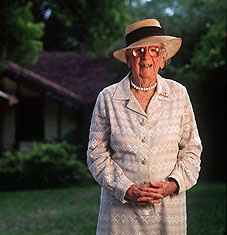

Marjory Stoneman Douglas was definitely a powerful
woman. She was often called the "Mother of the
Everglades," she was an environmentalist, activist,
feminist, and independent thinker longer than many of
us have been around. (She died in 1998 at 108 years
old). Her name is synonymous with the Everglades for
her tireless, ground-breaking efforts to protect this
watery region - a region her adversaries considered a
worthless swamp.
Ms. Douglas was perhaps most known for her best-selling
book, "The Everglades: River of Grass." First
published in 1947, River of Grass awakened residents
and visitors to the notion of the Everglades as a vast,
flowing river. Her descriptive, fluid prose portrays the
strange beauty of the region and diversity of its
wildlife; recounts the history of the native peoples,
explorers, and conquerors who traveled here; explains
its importance as the region's watershed; and
addresses modern civilization's impact on this fragile
ecosystem.
Ms. Douglas lived in South Florida from 1915 until she
died and through the decades, wrote extensively
about the region. Twenty years after publishing The River
of Grass, when she was 78, Ms. Douglas became
absorbed in the movement to preserve the Everglades.
She served on the committees to create Everglades
and Biscayne National Parks, formed the Friends of
the Everglades, and spearheaded legislation to protect
the parks and their wildlife. To defend this fragile
ecosystem, she wrote and spoke out about it. And,
whenever necessary, she went head-to-head with
government authorities with her respected,
straight forward approach to dealing with conservation
issues.
In her 1987 autobiography written with John
Rothchild, Marjory Stoneman Douglas: Voice of the
River,
Douglas summarizes the Everglades' role as the major
watershed for South Florida: "Much of the rainfall on
which South Florida depends comes from evaporation
in the Everglades. The Everglades evaporate, the
moisture goes up into the clouds, the clouds are blown
to the north, and the rain comes down over the
Kissimmee River and Lake Okeechobee. Lake
Okeechobee, especially, is fed by these rains. When
the lake gets filled, some of the excess drains down the
Caloosahatchee River into the Gulf of Mexico, or
throug hthe St. Lucie River and into the Atlantic
Ocean. The rest of the excess - the most useful part -
spills over the southern rim of the lake into the great
arc of the Everglades."
Douglas fused a fiery commitment to the Everglades
with her renowned tell-it-like-it-is approach. "Since
1972, I've been going around making speeches on the
Everglades. No matter how poor my eyes are I can
still talk. I'll talk about the Everglades at the drop of a
hat. Whoever wants me to talk, I'll come over and tell
them about the necessity of preserving the
Everglades," she reveals in her autobiography.
"Sometimes, I tell them more than they wanted to
know." She will be greatly missed. If you would like
to
learn more about Marjory Stoneman Douglas, just press
the next button to visit various web sites that contain
additional information about her.
 |
|